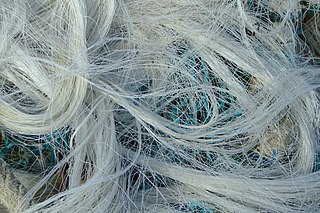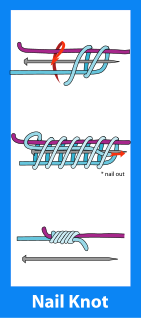
A knot is an intentional complication in cordage which may be practical or decorative, or both. Practical knots are classified by function, including hitches, bends, loop knots, and splices: a hitch fastens a rope to another object; a bend fastens two ends of a rope to each another; a loop knot is any knot creating a loop; and splice denotes any multi-strand knot, including bends and loops. A knot may also refer, in the strictest sense, to a stopper or knob at the end of a rope to keep that end from slipping through a grommet or eye. Knots have excited interest since ancient times for their practical uses, as well as their topological intricacy, studied in the area of mathematics known as knot theory.

A fishing line is a cord used or made for angling. Fishing lines generally resemble a long, thin string, and vary in material. Important attributes of a fishing line include length, material, weight, and thickness. Other factors relevant to certain fishing environments include breaking strength, knot strength, UV resistance, castability, limpness, stretch, abrasion resistance, and visibility. Most modern lines are made from nylon, braided polymers, or silk.

The dropper loop is a type of loop knot often used on multi-hook fishing lines. It can be created in the middle of a long line and forms a loop which is off to the side of the line.

Fly fishing is an angling method that uses a light-weight lure—called an artificial fly—to catch fish. The fly is cast using a fly rod, reel, and specialized weighted line. The light weight requires casting techniques significantly different from other forms of casting. The flies may resemble natural invertebrates, baitfish, or other food organisms.

A rope is a group of yarns, plies, fibers, or strands that are twisted or braided together into a larger and stronger form. Ropes have tensile strength and so can be used for dragging and lifting. Rope is thicker and stronger than similarly constructed cord, string, and twine.

A lucet is a tool used in cordmaking or braiding which is believed to date back to the Viking and Medieval periods, when it was used to create cords that were used on clothing, or to hang items from the belt. Lucet cord is square, strong, and slightly springy. It closely resembles knitted I-cord or the cord produced on a knitting spool. Lucet cord is formed by a series of loop like knots, and therefore will not unravel if cut. Unlike other braiding techniques such as kumihimo, finger-loop braiding or plaiting, where the threads are of a finite length, lucetted braids can be created without pre-measuring threads and so it is a technique suited for very long cords.

Rope splicing in ropework is the forming of a semi-permanent joint between two ropes or two parts of the same rope by partly untwisting and then interweaving their strands. Splices can be used to form a stopper at the end of a line, to form a loop or an eye in a rope, or for joining two ropes together. Splices are preferred to knotted rope, since while a knot typically reduces the strength by 20–40%, a splice is capable of attaining a rope's full strength. However, splicing usually results in a thickening of the line and, if subsequently removed, leaves a distortion of the rope. Most types of splices are used on 3-strand rope, but some can be done on 12-strand or greater single-braided rope, as well as most double braids.
While a spliced 3-strand rope's strands are interwoven to create the splice, a braided rope's splice is constructed by simply pulling the rope into its jacket.

Monofilament fishing line is fishing line made from a single fiber of plastic, as opposed to braided fishing line constructed from multiple fibers of material. Most fishing lines are now monofilament because monofilament fibers are cheap to produce and are produced in a range of diameters which have different tensile strengths. Monofilament line is also manufactured in different colors, such as clear, white, green, blue, red, and fluorescent.

The Albright special or Albright knot is a bend used in angling. It is a strong knot used to tie two different diameters of line together, for instance to tie monofilament to braid. The Albright is relatively smooth and passes through guides when required. Some anglers coat the knot with a rubber based cement to make it even smoother and more secure.

A Prusik is a friction hitch or knot used to attach a loop of cord around a rope, applied in climbing, canyoneering, mountaineering, caving, rope rescue, ziplining, and by arborists. The term Prusik is a name for both the loops of cord used to tie the hitch and the hitch itself, and the verb is "to prusik". More casually, the term is used for any friction hitch or device that can grab a rope. Due to the pronunciation, the word is often misspelled Prussik, Prussick, or Prussic.

The eye splice is a method of creating a permanent loop in the end of a rope by means of rope splicing.

The nail knot, also known as the tube knot or gryp knot, is mostly used in carp and fly-fishing. The nail knot was named because a nail was inserted as a guide when threading the line. Today, it is easier to use a small straw. The nail knot is an important fishing knot used to join two lines of different diameters and allows for line diameters to diminish down to the fly. I.E., it is useful for attaching your backing to the fly line, and your fly line to the leader, or tippet. The knot can be tied in multiple ways and is uniform.

The improved clinch knot, also known as the Salmon Knot, is a knot that is used for securing a fishing line to the fishing lure, but can also affix fishing line to a swivel, clip, or artificial fly. This is a common knot used by anglers because of its simple tie and strong hold. When more pull is being applied, the harder the knot turns into itself, increasing the strength of the connection. It can be used with many kinds of line including mono-filament, fluorocarbon, and braided fishing line.

The Palomar knot is a knot that is used for securing a fishing line to a fishing lure, snap or swivel.

In knot tying, a bight is a curved section or slack part between the two ends of a rope, string, or yarn. A knot that can be tied using only the bight of a rope, without access to the ends, is described as in the bight. The term "bight" is also used in a more specific way when describing Turk's head knots, indicating how many repetitions of braiding are made in the circuit of a given knot.
Braided line was one of the earliest types of fishing line, and in its modern incarnations it is still very popular in some situations because of its high knot strength, lack of stretch, and great overall power in relation to its diameter. Braids were originally made from natural fibers such as cotton and linen, but natural fiber braids have long since been replaced by braided or woven fibers of a man-made materials like Dacron, Spectra or micro-dyneema into a strand of line. Braided fishing lines have low resistance to abrasion, sharp objects can easily cut braided line. Their actual breaking strength will commonly well exceed their pound-test rating.

A bowstring joins the two ends of the bow stave and launches the arrow. Desirable properties include light weight, strength, resistance to abrasion, and resistance to water. Mass has most effect at the center of the string; one gram (0.035 oz) of extra mass in the middle of the string slows the arrow about as much as 3.5 grams (0.12 oz) at the ends.
A furled leader is a type of knotless tapered fly fishing leader. It is known for high performance, low memory, and soft artificial fly presentation when casting. These attributes are due to the way these leaders are constructed which is similar to creating rope. The big difference is that furled leaders are created with a taper. The twisted style of construction and being made from many filaments leads to a flexible leader with low to no memory like a section of rope.
The San Diego Jam knot is a common fishing knot used to tie a line to the hook, swivel, clip, or artificial fly. This knot is also known as the San Diego knot, Reverse clinch knot or Heiliger knot.




















